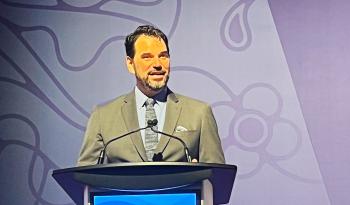Image Caption
Local Journalism Initiative Reporter
Windspeaker.com
On the final day of the First Nations Major Projects Coalition (FNMPC) conference in Toronto, which concluded April 29, co-emcee Jesse McCormick made a newsworthy announcement.
He revealed FNMPC officials had released the Indigenous Utilities Paper, subtitled The Emergence of Indigenous-Owned Electrical Utilities in Canada.
McCormick mentioned how Niilo Edwards, the FNMPC’s CEO and executive director who died this past December, was at last year’s conference discussing a national Indigenous electrification strategy.
“He noted you will see in the next decade the proliferation of Indigenous utilities across this country because that is what our electrification sector needs in order to meet its demand,” said McCormick.
Edwards had played a key role in the creation of the Indigenous Utilities Paper.
“Niilo was always keen to learn from experts and encouraged a small FNMPC team to visit four Arizona-based Indigenous utilities so that we could share their knowledge with our own member First Nations and beyond,” he said. “I know he would have been proud today to see this all come to fruition here.”
Field experts and officials from existing Indigenous-owned utilities were consulted for their input into the creation of the paper.
The Indigenous Utilities Paper is expected to be used as motivation by Indigenous communities across the country moving forward.
“The paper explores what Indigenous-owned utilities are, why Indigenous Nations form utilities, how the growth in the electricity sector is creating opportunities and what challenges Nations may face in creating them,” McCormick said.
Background information is also provided.
“One of the key insights that we discovered in this work was the existence of how many Indigenous-owned utilities there are across Turtle Island,” McCormick said. “The majority of them are in the United States. Those existing Indigenous-owned utilities are an inspiration and show what is possible in terms of economic reconciliation and own-source revenues as Canada builds out our own infrastructure.”
McCormick said the paper outlines a range of possible Indigenous utility models to help Indigenous nations, regulators, governments and others explore the potential of Indigenous-owned utilities.
The paper also offers 16 recommendations for First Nations and governments that would like to support Indigenous-owned utilities and their development in Canada. Eight of those recommendations are for Indigenous Nations. And the other eight are for governments, utilities and regulators.
The recommendations for Indigenous Nations are:
- Examine potential contractual relations with provincial/territorial utilities.
- Evaluate infrastructure and interconnection alternatives.
- Develop an electricity supply strategy.
- Establish wheeling contracts. (An agreement between a power seller and a power buyer that allows electricity generated by a third-party power plant via the seller's transmission system.)
- Understand and plan how electricity rates will be calculated and set.
- Create a legal structure for the Indigenous utility.
- Set up a board of directors for the Indigenous utility.
- Avoid pitfalls experienced by existing Indigenous utilities.
And recommendations for governments, utilities and regulators include asking the right questions, taking the regulatory steps needed to support the formation of Indigenous utilities and building the legal and regulatory frameworks needed to implement wheeling to allow Indigenous-led utilities to sell power to end users.
“Indigenous-owned utilities have the potential to amplify opportunities for First Nations in the electricity sector, including the relation to transmission lines and power generation infrastructure,” McCormick said. “Based on the thoughtful contributions of many experts, the paper sets out the conditions for successful development of Indigenous-owned utilities.”
The Indigenous Utilities Paper was funded by the Clean Economy Fund, a charitable public foundation whose mandate is to rally more philanthropy for high-impact climate solutions in Canada.
As for the FNMPC, it is a national non-profit organization whose mandate is to provide First Nation members with access to tools, advice and knowledge in order to make sound business decisions about First Nation involvement and participation in major natural resource and infrastructure projects.
This year’s FNMPC conference, the eighth annual, was held at the Sheraton Centre Toronto Hotel. About 1,800 delegates attended the event.
Local Journalism Initiative Reporters are supported by a financial contribution made by the Government of Canada.

